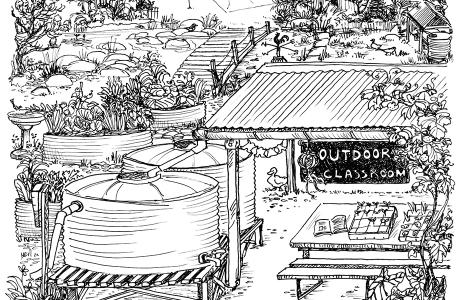How the garden works in educating children
How the Garden Works in Educating Children
A child’s surroundings influence their learning. Education in the garden leads them to be more inquisitive, more hands-on, to become highly motivated, goal-orientated and aware.
Teachers in schools throughout the country are choosing the food garden to foster children’s awareness of environmental issues. First, it moves children into a landscape that many children have forgone for an indoor life. Gardens are about plants and animals and the non-living elements of the landscape; the rocks, soil, water and energy – essential topics for learning for environmental awareness. Then there are the sensitivities that we all draw from a garden that have to do with the workings of nature and our connection to it.
When a child’s knowledge of nature’s elements, its rhythms, patterns and laws is diminished, or never fully developed, we may not be able to expect a level of responsibility towards the environment from this child.
It may fall upon schools to provide this outdoor experience for the young. Schools are accepting this challenge and we are working to support them with our resource materials and workshops.
The Best for the Children
Children’s gardens celebrate childhood and their world of play and curiosity about all things. They are places in the school ground for work and play among the playthings of the earth; where the dirt, sticks and stones are abundant and where they can enjoy growing gardens to learn, in a hands-on practical way, the secrets of the natural world.
Teachers will find benefits for themselves as much as for the children when they switch on children’s learning faculties in the outdoors. The journey to find joy and inspiration in the future is upon us all.
New Demands in Education
Food issues, economic concerns, human and planetary health and future sustainability are all under intense scrutiny today. These issues are manifested in the school setting as food and health choices, obesity, teaching and learning strategies, discipline issues, environmental awareness, values and attitudes training and essential learnings to mention a few.
In a world that is being reshaped with unnerving speed, teachers will be called upon to adjust their programs to meet the goals set down by the authorities who are promoting an education for sustainable development. The message is clear. Children need new skills and attitudes for life in the 21st century.
These attributes are outlined as, “the reflective and deep thinker, the autonomous learner, the ethical and responsible citizen, and the relevant and connected learner.” (Educating for a Sustainable Future, Australian Government, 2005,18).
They are high level skills indeed and we got glimpses of them developing in the children who were engaged in gardening projects at school.
How the Garden Works
The garden works as a transformative teaching and learning device. Where children learn influences how they learn.
The garden is an opportunity for teachers in primary schools to re-instate wisdoms about teaching and learning that have been set aside in many schools today, except perhaps, for the very young in the early classes.
These experiences include experiential and inquiry learning, both intrinsic parts of an outdoor activity such as gardening and both characteristic of the way children naturally learn. These techniques are central to the development of higher order thinking skills, deeper understanding and deeper questioning.
Hands-on, direct experience in a context relevant to the child, a maxim for early childhood educators, is an appropriate learning technique for all children in all classes in the primary school. Children need to continue to explore the world around them throughout their years at school. This form of learning has its place alongside the books and computers.
Children as gardeners can become highly motivated, goal oriented and aware of where they are going and how to get there. At this stage they are likely to self-direct and initiate projects for the group. They are on their way to be autonomous learners.
In the garden, teachers can slip easily into the role of facilitator and put aside the mantle of authority in deference to the children’s sovereignty over the garden. This sharing of authority empowers children to lead and be responsible for themselves and others. The benefits for a class working together with their teacher in this way are considerable. It is the seed for democratic action.
The garden fits seamlessly into the curriculum. The garden is the curriculum. Every action in the garden has its roots in some school subject whether it be science or maths or art. For the teacher-facilitator, finding the connections is not difficult.
There is no doubt that children learn well when they are put in charge of a garden. They work in the outdoors but more often in the indoor classroom, doing the research, organising the meetings, making the decisions, documenting their work and defining skills to be learnt before the next project can begin.
Moving Learning Outside
Many schools are prepared to invest heavily in their grounds to improve the facilities for learning. For example, some schools are using The Stephanie Alexander Kitchen Garden Foundation’s concept, which is an excellent model for getting the children gardening and cooking, but it does require considerable funding that is beyond the capacity of most schools’ budgets.
In most schools, the food garden is set up for moderate cost. The exercise need not be expensive though I do see an advantage in a capital works project that would benefit everyone at school, not only the gardeners, and that is a ‘classroom without walls’ structure in the grounds. Here teachers could gather their classes outdoors for any number of activities.
Whatever the project, big or small development of the school ground for learning is a good use of a resource that is, on hand, and largely untapped. There is great opportunity here for schools to shift direction and go forward with new vision.
We began writing Outdoor Classrooms with the following statements in mind: the modern child would need new experiences at schools to develop new skills. Teachers would need to revisit the wisdom that children learn by doing. Children would need to learn new behaviours in the outdoors and that the focus of learning would be child-centered.
We drew upon our experiences in classroom teaching, environmental education and permaculture, to produce ideas for teaching and learning for what was emerging as a new era in education.
By late 2008, the long awaited Outdoor Classrooms was ready and we moved into promotion mode. We handled book sales, ran workshops for teachers, visited schools and continued to work as we had done for many years, speaking at meetings, seminars and conferences and handling a great number of emails and calls from teachers and parents. The book is abundantly illustrated to carry the message that children need environmentally enhanced places to work, learn and play and moreover, to compensate for the ever-decreasing opportunities that they have to explore natural environments in the local area.
It contains 168 pages of authoritative insights into curriculum-connected ideas for the development of the schoolyard for learning. It leads teachers through the process of engagement and management and onto linking the outdoor activities throughout the curriculum.
It sets out skills and knowledge across twelve learning topics; Earth Resources/ Water/ Living Soils/ Climate/ Energy/ Plants/ Animals/ Trees / Landforms/ Patterns in Nature/ Buildings and Structures/Permaculture Design, at three sequential levels that will take the learning from observation and play through to understanding and research of the real world.
The book is reaching its targeted groups and the message that a school garden is a powerful teaching and learning tool for every school is spreading.
It’s All About the Children
The outdoor classrooms model is proving to benefit all children. However, there is a group who have responded to the activity in ways that are important. These are the learners, who are in every classroom, and who disengage from the activities set by their teacher. Often they are the same children who disrupt the class with bad behaviour. The stimulus and relevance of the garden, together with the physical work of handling tools is having a significant influence on these learners. They like to learn this way and they behave well. The improvement in discipline has been welcomed by teachers.


Leave a Reply
Want to join the discussion?Feel free to contribute!